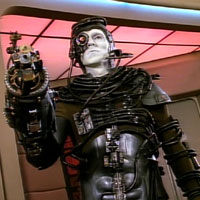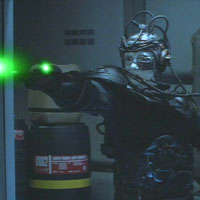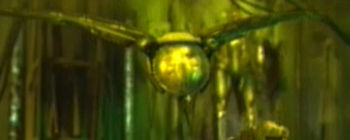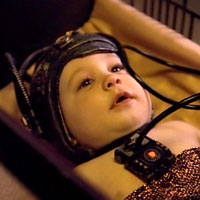Borg

Borg drone (TNG-174)

Borg drone (TNG-253)

Borg drone (STEXP2)

Borg infant (TNG-142)
The Borg were a partially organic, partially cybernetic race who apparently had their origins deep within the Delta Quadrant. The thoughts of the Borg were all joined in a hive-mind, or collective consciousness, and so the entire species operated as one gigantic organism, as if the Borg race was one huge entity and the individual drones and ships merely components of the greater whole. The Borg were technologically advanced and had conquered vast regions of space in their quest for perfection, which involved forcibly assimilating the races and technologies they encountered.[1]
The process of assimilation involved capturing members of other races and turning them into Borg drones by grafting cybernetic components onto them, and linking them into the Borg’s collective consciousness. This stripped them of their individuality.[2] It was not clear whether the Borg continued to procreate in a normal manner; there were nurseries on Borg ships, but it seemed conceivable that the Borg also assimilated infants.[1]
The Borg had assimilated thousands of races and cultures, adding their distinctive qualities to the Borg collective.[7] Entire races had had their worlds devastated by Borg raids. Many species in the Delta Quadrant, like the Farn and the Sakari, had been depopulated almost to extinction,[8] as had the El-Aurians, who migrated to the Alpha Quadrant.[6] All races that were assimilated were altered both physically and mentally, so that they become Borg drones. Each drone was fitted with cybernetic components and semiorganic units, called biochips, which increase the density of muscle fiber, and link the drone’s mind to the collective consciousness through a subspace communications network.[4]
Drones did not need to eat or drink, and could absorb energy directly through power conduits. When a drone was not needed it would take up a place in a regeneration alcove, where it could interface directly with its ship and the rest of the collective. Each Borg drone was adapted to serve a specific function; for example, there were tactical and surgical drones. All drones were given a designation that indicates their proper position and function. Typical Borg designations refer to groupings; thus a drone might be known as Two of Five, or Eight of Nine. If a drone’s function changes, it was given a new designation.
The minds of all Borg were joined together in the collective consciousness, and they always refer to themselves as “we;” the drones had no sense of individual identity, and no capacity for individual thought or action. Thanks to the subspace transcievers that were implanted in their necks, the Borg hear billions of voices speaking the same words simultaneously.[4]
Each drone’s experiences were processed by the collective. Useful information was then retained and distributed as necessary. In effect, what one Borg sees, all see, and thus each drone has access to the entire stored knowledge of the collective, and the thousands of databases and minds they had assimilated.[14] They did not think twice before sacrificing drones, but they would also go to great lengths to recover a drone that has been isolated from the rest of the collective; ships would be dispatched to rescue even one stranded drone[4]. If a Borg drone was “killed,” another Borg would remove some unidentified components and the disabled Borg would self-destruct[1]. Drones who were separated from the collective for one reason or another normally feel extremely stressed and would make every effort to re-establish contact.[12]
The Borg had no need for leaders in the conventional sense, because of their collective nature, although Borg Queens clearly provide a degree of direction for the collective.[7] Borg design reflects their social organization; their ships had no centralized command areas, and had a very generalized styling. The vessels appear to had so many redundant power sources that they could function even if they were 78 percent inoperable.[1]
The collective was also capable of distributing neural energies among its drones through this network, and the power could serve to regenerate injured Borg, or even regrow severed body parts. On a larger scale, this energy distribution could also “heal” damage inflicted on Borg ships.[9] The Borg group consciousness was divided into subcommands necessary to carry out all functions – defense, communication, navigation. They were all controlled by a root command. All critical subcommands, such as defense and power generation, were protected, but, in 2366, Data was able to access the Borg’s regenerative subcommand path and instructed them to enter the regeneration mode. This was believed to had caused a power feedback that destroyed the cube.[3]
The Borg did not manufacture, produce, or research any technologies or mechanisms – they had evolved a system where they simply take and assimilate whatever they need from whatever other species they encounter. Over the years the Borg had acquired extremely advanced technologies; their ships travel at transwarp speeds, which allows them to cross thousands of light years in relatively short periods of time, and the sophisticated subspace network that links the drones to one another could transmit information across vast distances at incredible speeds. The Borg also make extensive use of nanotechnology, which was an essential part of the assimilation process.[11]
Borg weapons were far more advanced than anything known to Starfleet. Borg cubes would often attack ships with weapons specifically designed to weaken their shields.[5] Individual drones could generate protective shields that could resist a phaser blast. But the Borg were vulnerable to technology that they had not encountered before. For example, their shields only protect them from specific phaser frequencies that they had already come up against. But the Borg were extremely adaptable and could alter their technology and their tactics to deal with a wide range of situations; they rapidly add to their store of knowledge and develop new defenses. In practice, this means that no attack on the Borg was effective more than once. When attacking a species about which the Borg know very little, they may assimilate one of their enemies’ leaders to gain detailed strategic information and tactical awareness. For example, when they invaded Federation space they assimilated Starfleet Captain Jean-Luc Picard and used his specialist knowledge to destroy an armada of Starfleet ships at Wolf 359.[2]
It may seem strange to describe the Borg as inquisitive, but they were constantly exploring the galaxy in search of new species and information that they could assimilate. Everything that the Borg encounter was instantly catalogued and given a designation; each species receives a number.[10] When the Borg encounter a spacecraft they would scan it, and possibly take part of the ship as a sample for study. When the Borg encounter a race they assess it for its potential usefulness to the collective and, if it was deemed appropriate, they would then begin the process of assimilation.[1] The Borg would always tell their victims that resistance was futile, although many races had resisted them. The Borg even assigned a resistance quotient to each species, indicating how successfully they withstand assimilation.[15]
The Borg believe that their collective nature was inherently superior to the “disorganized” societies that they encounter. To them, individuality was weakness. The Borg did not had any gods, but they did had a belief system that verged on the religious. They believe that their observation of the universe shows that all forms of intelligent life share a common goal: to improve themselves. And those races which did not improve themselves perish. For the Borg, this was the only purpose of existence and they were firmly convinced that they would reach perfection before any other race. The Borg believe that their combination of the organic and synthetic gives them the best of both worlds, and brings them closer to perfection than the other races they had encountered; they also think they were helping other races to approach perfection by assimilating them.[7]
The Borg had an almost religious reverence for the Omega particle; because it was infinitely complex but still harmonious, it represents perfection to them. They first heard of the incredibly dangerous particle when they passed through Sector 353 and assimilated several worlds whose cultures had stories about the destruction of a planet.
On one occasion, the Borg were able to create a single Omega molecule, and managed to keep it stable for on trillionth of a nanosecond before it exploded. The explosion destroyed five systems, 29 vessels, and 11 million drones, but the Borg were not deterred. As yet, they had not been able to manufacture another Omega molecule, but they had refined their theories and believe that they would be able to stabilize Omega in the future.[13]
The Borg regard everything that would not aid them in their quest for perfection as irrelevant, and had no time for creativity, considerations of comfort, or concepts such as friendship. This total focus on what was “relevant” could prove dangerous to the Borg. For example, uninvited visitors to a Borg ship would often be ignored until they pose an immediate threat. In the Alpha Quadrant, this enabled Starfleet to gather a considerable amount of information during the Borg’s first attempt to invade Federation space in 2366.[2]
The Borg were also extremely vulnerable when they could not assimilate an enemy. They were almost wiped out when they attempted to assimilate Species 8472, a malevolent race from another dimension, known as Fluidic Space, that was completely resistant to their assimilation technology. The Borg survived only by cooperating with Captain Kathryn Janeway of the USS Voyager NCC-74656; the Starfleet crew developed a weapon that could destroy the species in exchange for safe passage through Borg territory.[10]
Related Entries
Notable Borg
- Borg Queen[7]
- Locutus[2]
References
- 1. “Q Who.” Star Trek: The Next Generation, Episode 142. Television. 8 May 1989.
- 2. “The Best of Both Worlds.” Star Trek: The Next Generation, Episode 174. Television. 18 June 1990.
- 3. “The Best of Both Worlds, Part II.” Star Trek: The Next Generation, Episode 175. Television. 24 September 1990.
- 4. “I, Borg.” Star Trek: The Next Generation, Episode 223. Television. 11 May 1992.
- 5. “Emissary.” Star Trek: Deep Space Nine, Episodes 401-402. Television. 4 January 1993.
- 6. Star Trek: Generations. Film. 18 November 1994.
- 7. Star Trek: First Contact. Film. 22 November 1996.
- 8. “Blood Fever.” Star Trek: Voyager, Episode 157. Television. 5 February 1997.
- 9. “Unity.” Star Trek: Voyager, Episode 159. Television. 12 February 1997.
- 10. “Scorpion.” Star Trek: Voyager, Episode 168. Television. 21 May 1997.
- 11. “The Gift.” Star Trek: Voyager, Episode 170. Television. 10 September 1997.
- 12. “The Raven.” Star Trek: Voyager, Episode 174. Television. 8 October 1997.
- 13. “The Omega Directive.” Star Trek: Voyager, Episode 189. Television. 15 April 1998.
- 14. “Infinite Regress.” Star Trek: Voyager, Episode 203. Television. 25 November 1998.
- 15. “Dark Frontier, Part II.” Star Trek: Voyager, Episode 212. Television. 17 February 1999.
Leave a Reply
Categories
- Animated Series (60)
- Articles (28)
- Books (447)
- Cast & Crew (79)
- Comics (22)
- DS9 (328)
- Early Voyages (125)
- Education (5)
- Enterprise (373)
- Excelsior (36)
- Food (19)
- Games (223)
- Klingon (70)
- Library (1,543)
- Logs (593)
- Lost Era (55)
- Medicine (18)
- Merrimac (1)
- Mirror (35)
- Miscellaneous (13)
- New Frontier (54)
- Next Generation (635)
- Original Series (681)
- Personnel (436)
- Places (369)
- Politics (12)
- Recreation (10)
- SCE (41)
- Science (1)
- Shatnerverse (9)
- Ships (455)
- Site Updates (98)
- Starfleet Academy (86)
- Stargazer (42)
- STO (61)
- Technology (45)
- Titan (59)
- To Boldly Go (1)
- TV/Film (214)
- Uncategorized (4)
- Vanguard (76)
- Voyager (236)
- Weapons (27)
- Xenology (54)